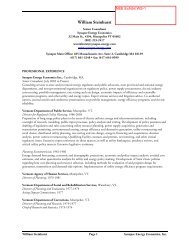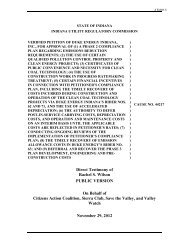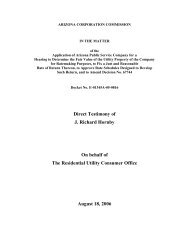Best Practices in Energy Efficiency Program Screening - Synapse ...
Best Practices in Energy Efficiency Program Screening - Synapse ...
Best Practices in Energy Efficiency Program Screening - Synapse ...
Create successful ePaper yourself
Turn your PDF publications into a flip-book with our unique Google optimized e-Paper software.
funded energy efficiency programs. Most states have some type of legal requirement for<br />
the use of such tests, either by legislation or regulatory order (ACEEE 2012, p.30).<br />
Many states exam<strong>in</strong>e more than one benefit-cost test. The ACEEE survey found that<br />
36 states (85 percent) apply the TRC test; 28 states (63 percent) apply the PAC test; 23<br />
states (53 percent) apply the Participant Test; 22 states (51 percent) apply the RIM test,<br />
and 17 states (40 percent) apply the Societal Cost Test (ACEEE 2012, p.12).<br />
However, regulators tend to adopt one of these tests as the primary guidel<strong>in</strong>e for<br />
screen<strong>in</strong>g energy efficiency programs. The ACEEE survey found that 95 percent of<br />
states rely on a s<strong>in</strong>gle, primary screen<strong>in</strong>g test:<br />
The TRC is used by 29 states (71 percent) as the primary methodology for<br />
def<strong>in</strong><strong>in</strong>g energy efficiency cost-effectiveness.<br />
The Societal Cost test is used by six states (15 percent) as the primary<br />
methodology for def<strong>in</strong><strong>in</strong>g energy efficiency cost-effectiveness.<br />
The PAC test is used by five states (12 percent), as the primary methodology for<br />
def<strong>in</strong><strong>in</strong>g energy efficiency cost-effectiveness<br />
The RIM test is used by one state (2 percent), as the primary methodology for<br />
def<strong>in</strong><strong>in</strong>g energy efficiency cost-effectiveness (ACEEE 2012, p.13).<br />
2.2 Implications of the Cost-Effectiveness Tests<br />
In theory, all of the above cost-effectiveness tests should be considered <strong>in</strong> the evaluation<br />
of ratepayer-funded energy efficiency resources, to provide the most complete picture of<br />
the impacts on different parties. However, most states rely upon one or two tests as the<br />
primary standard for screen<strong>in</strong>g energy efficiency programs, due to the challenges of<br />
work<strong>in</strong>g with multiple tests that provide different results.<br />
Also, it is important to recognize that the different tests provide different types of<br />
<strong>in</strong>formation and should be used for different purposes. The RIM test and the Participant<br />
test provide "distributional" <strong>in</strong>formation, i.e., <strong>in</strong>formation regard<strong>in</strong>g how the impacts of<br />
energy efficiency are distributed across customers. In particular, the RIM test provides<br />
an <strong>in</strong>dication of the primary impacts of energy efficiency on those customers who do not<br />
participate <strong>in</strong> the energy efficiency programs, because the ma<strong>in</strong> impacts on these<br />
customers are the adjustments <strong>in</strong> rates result<strong>in</strong>g from energy efficiency. The Participant<br />
test, on the other hand provides an <strong>in</strong>dication of the primary impact of energy efficiency<br />
on the program participants. These two tests together provide a rough <strong>in</strong>dication of how<br />
the benefits are distributed between program participants and non-participants.<br />
In the paragraphs below we summarize some of the key implications of each of the five<br />
cost-effectiveness tests. Table 2.2 summarizes some of the key po<strong>in</strong>ts.<br />
The Societal Cost test is the most comprehensive standard for evaluat<strong>in</strong>g the costeffectiveness<br />
of efficiency, because this is the only test that <strong>in</strong>cludes all benefits and<br />
costs to all members of society. Ideally, the Societal Cost test should <strong>in</strong>clude all costs<br />
and benefits, <strong>in</strong>clud<strong>in</strong>g externalities, regardless of who experiences them.<br />
| 14 <strong>Best</strong> <strong>Practices</strong> <strong>in</strong> <strong>Energy</strong> <strong>Efficiency</strong> <strong>Program</strong> Screen<strong>in</strong>g | www.nhpci.org







